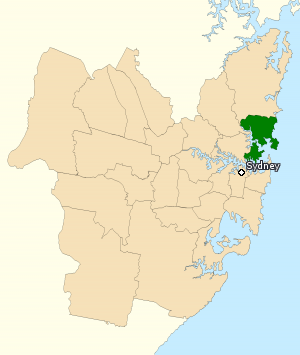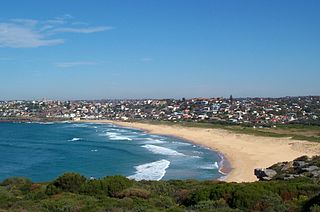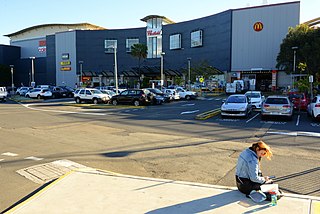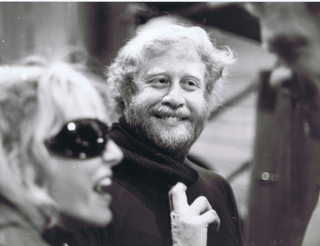Brutalist architecture is an architectural style that emerged during the 1950s in the United Kingdom, among the reconstruction projects of the post-war era but commonly known for its presence in post-war communist nations. Brutalist buildings are characterised by minimalist constructions that showcase the bare building materials and structural elements over decorative design. The style commonly makes use of exposed, unpainted concrete or brick, angular geometric shapes and a predominantly monochrome colour palette; other materials, such as steel, timber, and glass, are also featured.

The Northern Beaches is a region within Northern Sydney, in the state of New South Wales, Australia, near the Pacific coast. This area extends south to the entrance of Port Jackson, west to Middle Harbour and north to the entrance of Broken Bay. The area was formerly inhabited by the Garigal or Caregal people in a region known as Guringai country.

Pittwater Council was a local government area on the Northern Beaches of Sydney, in the state of New South Wales, Australia. It covered a region adjacent to the Tasman Sea about 30 kilometres (19 mi) north of the Sydney central business district. The area is named after Pittwater, the body of water adjacent to much of the area governed. First proclaimed in 1906 as the A Riding of Warringah Shire, the area was proclaimed as the Municipality of Pittwater on 1 May 1992. On 12 May 2016, the Minister for Local Government announced that Pittwater Council would be subsumed into the newly formed Northern Beaches Council. The last mayor of Pittwater Council was Councillor Jacqui Townsend, an independent politician.

Warringah Council was a local government area in the northern beaches region of Sydney, in the state of New South Wales, Australia. It was proclaimed on 7 March 1906 as the Warringah Shire Council, and became "Warringah Council" in 1993. In 1992, Pittwater Council was formed when the former A Riding of Warringah Shire voted to secede. From this point on until amalgamation, Warringah Council administered 152 square kilometres (59 sq mi) of land, including nine beaches and 14 kilometres (9 mi) of coastline. Prior to its abolition it contained 6,000 hectares of natural bushland and open space, with Narrabeen Lagoon marking Warringah's northern boundary and Manly Lagoon marking the southern boundary.

Wynyard railway station is a heritage-listed underground commuter rail station located in the north-west precinct of the Sydney central business district, in New South Wales, Australia. The station opened on 28 February 1932 to coincide with the opening of the Sydney Harbour Bridge.

Dee Why is a coastal suburb of northern Sydney, in the state of New South Wales, Australia, 18 kilometres north-east of the Sydney central business district. It is the administrative centre of the local government area of Northern Beaches Council and, along with Brookvale, is considered to be the main centre of the Northern Beaches region.

The Division of Warringah is an Australian electoral division in the state of New South Wales.
Forestville is a suburb of Northern Sydney, in the state of New South Wales, Australia. Forestville is 12 kilometres north of the Sydney central business district in the local government area of Northern Beaches Council. Forestville is part of the Forest District.
Warringah is a name taken from the local Aboriginal word for Middle Harbour, in Sydney, New South Wales, Australia. It may refer to:

Curl Curl is a suburb of northern Sydney in the state of New South Wales, Australia, 18 kilometres (11 mi) north-east of the Sydney central business district, in the local government area of Northern Beaches Council. It is part of the Northern Beaches region.

Brookvale is a suburb of northern Sydney, in the state of New South Wales, Australia. Brookvale is 16 kilometres north-east of the Sydney central business district, in the local government area of Northern Beaches Council. It is part of the Northern Beaches region.

Westfield Warringah Mall is a large indoor/outdoor shopping centre in the suburb of Brookvale in the Northern Beaches region of Sydney.
Colin Frederick Madigan AO was an Australian architect. He is best known for designing the National Gallery of Australia in Canberra.
Michael John Regan is an Australian politician and former public servant. He was mayor of Warringah Council from 13 September 2008 to May 2016 following its amalgamation into the Northern Beaches Council. In September 2017, Regan was elected as the first Mayor of Northern Beaches Council, holding office until May 2023. At the March 2023 state election, Regan was elected to the NSW Legislative Assembly seat of Wakehurst, which covers a large portion of the area of Northern Beaches Council.

The Mackellar County Council (MCC) was a state–owned enterprise of the Government of New South Wales, Australia. Established in 1951, it was an electricity and gas supplier and retailer which primarily supplied the Northern Beaches area of Sydney, New South Wales, being jointly managed and operated by Manly Municipal Council and Warringah Shire Council.

The Warringah Shire Hall was an Australian municipal town hall located on Pittwater Road opposite Robert Street in Brookvale, a suburb of the Northern Beaches of Sydney, New South Wales. Initially built in 1910 as a Federation bungalow, the complex was expanded with the addition of "Shire Hall" in 1912, the final form was completed in 1923 with the addition of a second floor to a design by Trenchard Smith and Maisey. The Shire Hall was the seat of Warringah Council from 1910 to 1973, when the council moved to a new purpose-built Civic Centre on further down Pittwater Road in Dee Why. The Shire Hall survived amid uncertainty over its future but was eventually sold and demolished in 1978.

The Northern Beaches Council is a local government area located in the Northern Beaches region of Sydney, in the state of New South Wales, Australia. The council was formed on 12 May 2016 after the amalgamation of Manly, Pittwater, and Warringah councils.

Feiko Bouman is a Dutch Australian architect and author, best known for his outback museum, The Australian Stockman’s Hall of Fame, Longreach Queensland. The building was opened by Queen Elizabeth in 1988.

The High Court of Australia building is located on the shore of Lake Burley Griffin in Canberra's Parliamentary Triangle. It has been the permanent home of the High Court of Australia since 1980. The High Court building was designed between 1972 and 1974 by the Australian architect Christopher Kringas (1936–1975) – a director of the firm Edwards Madigan Torzillo and Briggs – who is commemorated by a plaque in the public hall.

Christopher Kringas (1936-1975) is best known as the architect of the High Court of Australia.


















